
Ghai Essential Pediatrics8th
.pdf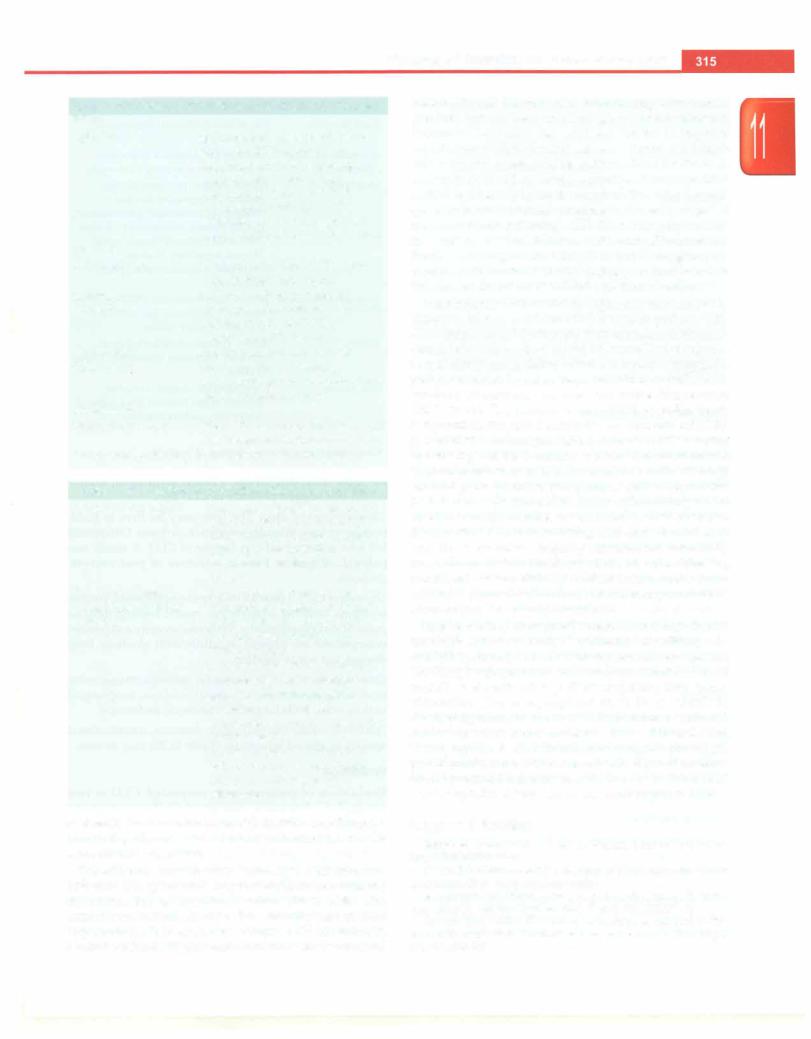
Diseases of Gastrointestinal System and Liver
Table 11.27: Investigations for specific causes of acute liver failure
Infectious |
IgM anti-HAV (hepatitis A virus) |
|
IgM anti-HEV(hepatitis E virus) |
|
Hepatitis B surface antigen, IgM |
|
antihepatitis B core antigen |
|
(hepatitis B virus) CMV PCR |
|
(cytomegalovirus) IgM VZV |
|
(varicella zoster virus, IgM viral |
|
capsid antigen (Epstein-Barr virus) |
Metabolic |
|
Wilson disease |
Ceruloplasmin, Kayser-Fleischer |
|
ring, 24 hr urinary copper |
Autoimmune |
Anti liver kidney microsomal |
hepatitis |
antibody;antinuclearantibody; anti |
|
smooth muscle antibody; |
|
immunoglobulin levels |
Tyrosinemia |
Urinary succinylacetone level |
Galactosemia |
Urine nonglucose reducing |
|
substances, galactose-1-phosphate |
|
uridyl transferase level |
Miscellaneous |
|
Hemophagocytosis |
Triglyceride, ferritin, fibrinogen and |
|
bone marrow biopsy |
Paracetamol poisoning |
Plasma levels of paracetamol |
Table 11.28: Monitoring of children with acute liver failure
Clinical examination |
Pulse rate, respiratory rate, blood |
|
pressure, temperature (q 4 hr) |
|
Intake-output charting (q 6 hr) |
|
Liver span, neurological |
|
monitoring, grading of coma |
|
(q 12 hr) |
Biochemical tests (at |
Blood sugar, electrolytes, pH, |
diagnosis, repeat as |
bicarbonate, lactate (q 6-12 hr) |
shown) |
Prothrombin time (INR) (daily) |
|
Complete blood counts, CRP |
|
(twice a week) |
|
Transaminases, GGTP, alkaline |
|
phosphatase, lactate dehydro |
|
genase, total and conjugated |
|
bilirubin (twice a week) |
|
Creatinine, calcium, phosphate |
|
(twice a week) |
|
Monitor as needed: Evidence of |
|
infection on chest X-ray, blood |
|
and urine cultures; blood |
|
ammonia |
andventilation is beneficial in subjects withstage3 hepatic encephalopathy or more. The hemodynamics need to be assessed and supported.
Raised intracranial pressure is managed with mannitol 20% (0.5 to 1 g/kg with target osmolality not crossing 320 mOsm/kg) or hypertonic saline (3% to 30%). The targetserumsodiumshouldbe145-155mEq/1 to maintain hypertonicity. The head end is kept at 30° elevation in neutral position. Hyperventilation to decrease cerebral
edema should be transient. Monitoring intracranial pressure has not been convincingly shown to improve outcomes. Lactulose has not been shown to improve hepatic encephalopathy and outcome. Bowel decontami nation by oral nonabsorbable antimicrobials (to decrease ammonia load and to decrease infections) has been tried in ALF but does not alter the survival. Recently N-acetyl cysteine has shown some promise in the early stages of nonparacetamol poisoning ALF. Phenytoin may be used for treating seizures. Normal maintenance intravenous fluids containing dextrose are given and blood glucose is monitored to prevent and treat hypoglycemia. Electrolyte imbalances should be identified and treated early.
Prophylactic antimicrobial regimens have not been shown to improve outcome or survival in patients with ALF. Empirical antibiotics are recommended in circums tances with high-risk of sepsis, i.e. surveillance cultures reveal significant isolates, advanced hepatic encephalo pathy, refractory hypotension, renalfailureorpresenceof systemic inflammatory response syndrome (temperature >38°C or <36°C, leukocyte count >12,000 or <4,000/mm3, tachycardia). Empirical antibiotics are recommended for patientslistedfortransplantation,becauseinfectionsresult in delisting and these patients need immunosuppression in postoperative phase. Antimicrobials with coverage against gram-positive and gram-negative organisms (cefotaxime with cloxacillin) along with antifungals are used. Aminoglycosides are avoided to prevent renal dysfunction. Close monitoring and early detection of infection is essential. Coagulopathy does not necessarily warranttransfusionoffreshfrozenplasmaunlessbleeding manifestations are clinically evident or an invasive inter vention is planned or INR is >7. Proton pump inhibitions are used for stress ulcer prophylaxis.
Inspiteofadequatesupportivecare, themortalityinALF is as high as 60-70%. Early identification of children who would benefit only from liver transplantationis essential. The King's college criteria are one of the commonly used criteria to identify adult patients requiring liver trans plantation. However, application of these criteria in developing countries seems to be limiteddueto variation in etiology other than paracetamol induced liver failure. Young age ($.3.5 yr), bilirubin 16.7 mg/dl, prolonged prothrombin time (>40 seconds) and signs of cerebral edemapredictedmortality in an Indian study. Table 11.29 lists the specific therapy for common etiologies of ALF.
Suggested Reading
Bernal W, Auzinger G, Dhawan A, Wendon J. Acute liver failure. Lancet 2010;376:190-201
Polson J, Lee WM. AASLDpositionpaper: the management of acute liver failure. Hepatology 2005;41:1179-97
Shanmugam NP, Bansal S, Greenough A, et al. Neonatal liver fail ure: etiologies and management. Eur J Pediatr 2011;170:573-81
Srivastava A, Yachha SK, Poddar U.Predictors of outcome in chil dren with acute viral hepatitis and coagulopathy. J Viral Hepat 2012;19:el94-201
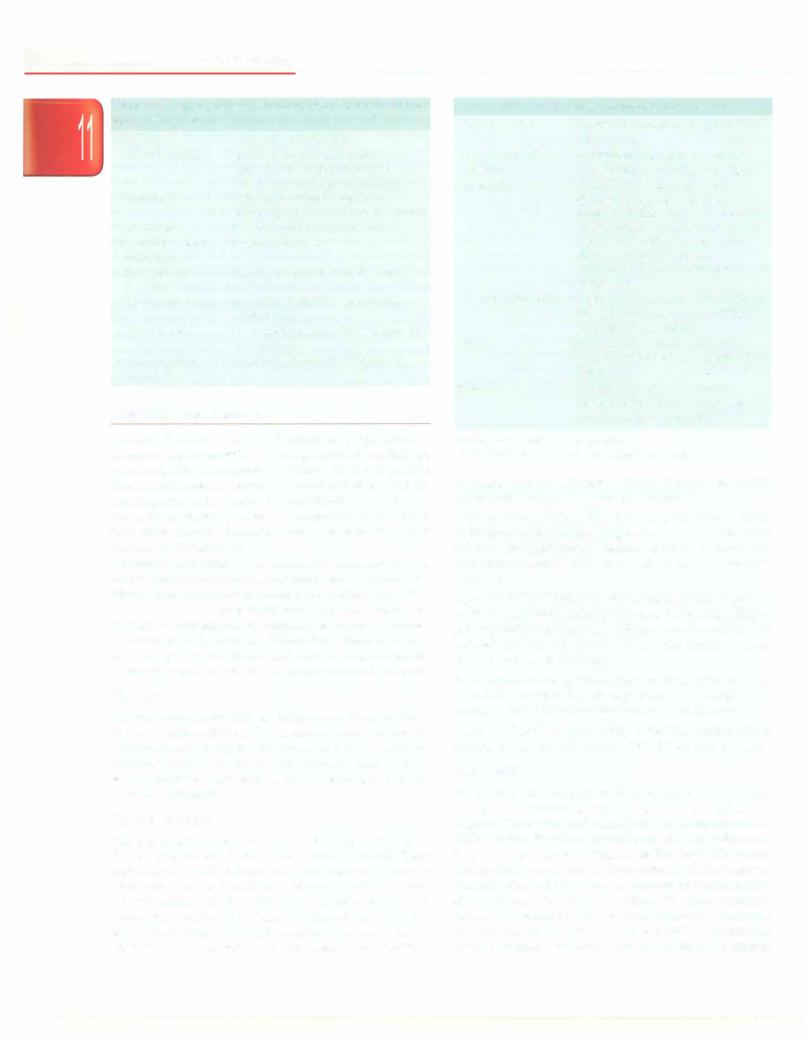
-i..._Es_s_e_n_ _tia_l_P_e_d_ i_a _tr_ic_s_________________________________
Table11.29: Specific treatment of conditions causing pediatric acute liver failure
Neonatal |
Antioxidants; chelation; |
|
hemochromatosis |
prenatal intravenous immuno |
|
|
globulin |
in combination with |
|
postnatal |
exchange transfusion |
Tyrosinemia |
Nitisinone (NTBC); restriction |
|
|
of phenylalanine and tyrosine in diet |
|
Galactosemia |
Galactose and lactose free diet |
|
Hereditary fructose |
Fructose free diet |
|
intolerance |
|
|
Mitochondrial |
Coenzyme QlO, vitamin E, carnitine |
|
cytopathies |
|
|
Amanita poisoning |
Penicillin G, silibinin and N-acetyl |
|
|
cysteine |
|
Herpes simplex |
High dose acyclovir (60 mg/kg/day) |
|
|
for 21 days |
|
Acetaminophen |
N-acetyl cysteine (see Chapter 26) |
|
poisoning |
|
|
CHRONIC LIVER DISEASE
Chronic liver disease (CLO) refers to a spectrum of disorders characterized by ongoing chronic liver damage and a potential to progress to cirrhosis or end stage liver disease. Although a 6-month duration cut off is used for defining chronicity related to hepatitis B and C, it does not apply to the other causes as irreversible liver damage may have already taken place before symptoms of liver disease are recognized.
Cirrhosis is a diffuse liver process characterized by cell injury (necrosis) in response to inflammation/injury and fibrosis and regeneration (nodule formation). When the disease is silent, the patient may have hepatospleno megaly and abnormal liver function tests and it is termed as compensated cirrhosis. When the patient develops jaundice, gastrointestinal bleed, ascites and/or hepatic encephalopathy, it is known as decompensated cirrhosis.
Etiology
The main causes of CLO in children are listed in Table 11.30. In India, -25% of CLO is due to metabolic causes (Wilson disease being the commonest), 8-15% are due to hepatitis B and 2-4% due to autoimmune causes. Nearly 40% patients do not have a known etiology, and are labeled cryptogenic.
Clinical Features
The presentation depends on the etiology and pace of disease progression. Patients may present with insidious onset disease with failure to thrive, anorexia, muscle weakness and/or jaundice or abruptly with massive gastrointestinal bleed, acute onset jaundice, along with altered sensorium and ascites. Sometimes the patient may be asymptomatic and child is noticed to have hepato splenomegaly orelevatedtransaminases on investigations
Table 11.30: Causes of chronic liver disease
Viral hepatitis |
Hepatitis B (common), hepatitis C |
|
(uncommon) |
Autoimmune liver |
Autoimmune hepatitis (common), |
disease |
autoimmune sclerosing cholangitis |
Metabolic |
Wilson disease, glycogen storage |
|
disease*, progressive familial |
|
intrahepatic cholestasis*, galactosemia*, |
|
NASH related, tyrosinemia*, Indian |
|
childhood cirrhosis* (rare), cystic |
|
fibrosis, hereditary fructose |
|
intolerance, alpha-1-antitrypsin |
|
deficiency |
Venous obstruction |
Budd-Chiari syndrome, veno-occlusive |
|
disease, constrictive pericarditis, |
|
congestive heart failure |
Biliary |
Biliary atresia*, choledochal cyst*, |
|
primary sclerosing cholangitis, Caroli |
|
disease |
Rare causes |
Niemann-Pick disease, Gaucher |
|
disease; cystic fibrosis; drug induced |
|
(valproate, carbamazepine) |
NASH nonalcoholic steatohepatitis
*Causes in infants and young children <5 yr of age
for some unrelated illness. Clinical features on exami nation that suggest presence of CLO are:
Characteristics of liver. The liver may be firm to hard, nodularorhaveirregularmarginsin cirrhosis.Differential left lobe enlargement is a feature of CLO. A small, non palpable shrunken liver is a feature of post necrotic cirrhosis.
Stigmata ofCLD. These include spider angiomata, palmar erythema, clubbing, leukonychia, musclewasting, delayed puberty andgynecomastia. Testicular atrophy andparotid enlargement are present in adults with alcoholic liver disease, but not in children.
Portal hypertension. Splenomegaly, ascites, tortuous veins over abdominal wall, i.e. caput medusa; esophageal varices with/without gastric varices on endoscopy.
Features ofhepatic encephalopathy. Asterixis, constructional apraxia or altered sensorium (Table 11.26) may be seen.
Evaluation
Evaluation of patients with suspected CLO is two pronged: (i) determine etiology of CLO and (ii) assess degree of liver dysfunction andpresenceof complications (Table 11.31). Based on clinical and laboratory features, liver damage is graded using scores like the CHILD score and pediatric end stage liver disease (PELO) score. Complications of CLO are: (i) hepatic encephalopathy;
(ii)portal hypertension with variceal bleeding, portopul monary hypertension and hepatopulmonary syndrome;
(iii)ascites and spontaneous bacterial peritonitis;
(iv)hepatorenal syndrome; (v) coagulopathy; (vi) nutrition
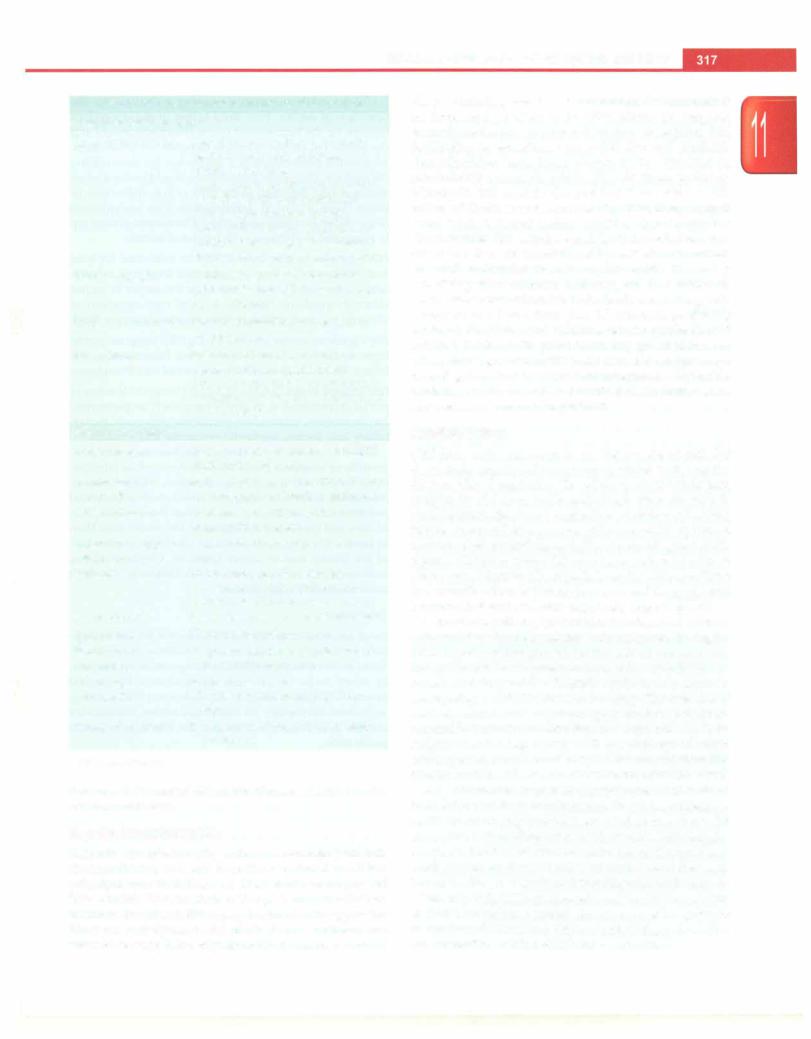
Diseases of Gastrointestinal System and Liver
Table 11.31: Investigations for chronic liver disease Common investigations
Liver function tests |
Low albumin, reversal of albumin |
|
globulin ratio and prolonged |
|
prothrombin time |
|
High conjugated bilirubin suggests |
|
liver dysfunction or obstruction |
|
Raised transaminases suggest |
|
hepatocellular injury; raised alkaline |
|
phosphatase and gamma glutamyl |
|
transpeptidase suggest biliary disease |
Ultrasonography |
Nodular liver, mass lesion, dilated |
|
portal vein and collaterals, ascites, |
|
splenomegaly |
Upper GI endoscopy |
Portal hypertension: esophageal or |
|
gastric varices |
Liver biopsy |
Breaking of lamina limitans and |
|
lobular inflammation; nodule |
|
formation and loss of architecture in |
|
cirrhosis; may also aid in diagnosis of |
|
specific diseases |
Specific to etiology |
|
Viral markers |
HBsAg, HBeAg, anti-HBe, anti-HCV, |
|
HBV DNA, HCV RNA |
Autoimmune |
Anti-smooth muscle, anti-liver kidney |
hepatitis |
microsomal, antinuclear antibodies |
Wilson disease |
Ceruloplasmin, KF ring; 24 hr urine |
|
copper; liver copper |
Alpha-1-antitrypsin |
Serum alpha-1-antitrypsin levels; PI |
deficiency |
type |
Galactosemia |
Positive nonglucose reducing |
|
substances in urine; galactose-1- |
|
phosphate uridyl transferase assay |
Cystic fibrosis |
Sweat chloride test; genetic analysis |
Tyrosinemia |
Urinary succinylacetone level |
Budd-Chiari |
Doppler ultrasonography for hepatic |
syndrome |
vein, inferior vena cava |
Sclerosing |
Magnetic resonance |
cholangitis |
cholangiopancreatography; liver |
|
biopsy |
Storage disorders |
Bone marrow, fundus examination; |
|
liver biopsy |
KF Kayser-Fleischer |
|
failure; (vii) increased risk of infections; and (viii) hepato cellular carcinoma.
Hepatic Encephalopathy
Hepatic encephalopathy refers to neuropsychiatric abnormalities that result from liver dysfunction. It is a principal manifestations of CLO and can be graded (Table 11.26). Various factors like gastrointestinal bleed, infection, use of sedatives, dehydration due to aggressive diuresis, constipation and electrolyte imbalance can precipitate encephalopathy. Identification and reversal of
the precipitating event is of importance. As ammonia is an important putative metabolite, efforts are targeted towards reducing its production and absorption and facilitating its excretion. Oral antibiotics and synthetic disaccharides have been shown to be effective in minimizing ammonia production in these patients. Neomycin was used in the past but it has serious side effects of deafness and renal toxicity. Rifaximin is a new drug with a better safety profile. Nonabsorbable disaccharides like lactulose and lactitol reach the colon intact and then are metabolized by bacteria into variety of small molecular weight organic acids. It acts by acidifying fecal contents and trapping the diffusible ammonia as ammoniumioninthefecalstream along with alteration in colonic flora (loss of ammonia producing bacteria). In infants and children, protein intake should not be restricted to the point of causing growth failure or compromising overall nutritional status and a target range of 1-2 g/kg/day is often recommended. Vegetable proteins, which are rich in branched chain amino acids are preferred over animal proteins.
Nutrition Failure
Children with end-stage liver disease are at risk for developing nutritional compromise, which increases the disease related morbidity. The etiology of failure to gain weight in children with end-stage liver disease is multifactorial, due to a combination of decreased caloric intake, increased energy expenditure, malabsorption of macro andmicronutrientsandalteredphysiologic anabolic signals. Children with CLO also have reduced levels of liver-derived insulin like growth factor 1, which mediates the anabolic action of growth hormone and thus a growth hormone resistant state that negatively impacts growth.
Clinicalrecognitionofmalnutritionininfantsandchildren withend-stageliverdiseaserelieson careful monitoringfor clinical features like growth failure, loss of muscle mass, delayedmotordevelopmentorsignsoffat-solublevitamin or essential fatty acid deficiencies (skin rash, peripheral neuropathy, rickets/fractures or bruising). Thepresenceof ascites, edema and organomegaly makes weight an unreliable indicator of nutrition in a child with CLO. So height monitoring, along with assessment of other anthropometric markers ofbody fat and muscle mass like tricepsskinfoldandmid-armcircumferenceshouldbeused.
All patients need increased caloric intake -120-150% of their estimated daily requirements. Formulas containing medium-chain triglycerides are used to maximize fat absorptioninthesettingofseverecholestasis. Dailysupple mentsofvitaminsandothernutrientslikecalciumandiron need to be given. For patients who cannot meet the needs byoralfeeding,nasogastrictubefeedingsshouldbestarted.
Patients with CLO are especially vulnerable to viral and bacterial infections. Careful attention must be given to ensurethat all infants andchildren withCLO receive entire recommended routine childhood vaccinations.
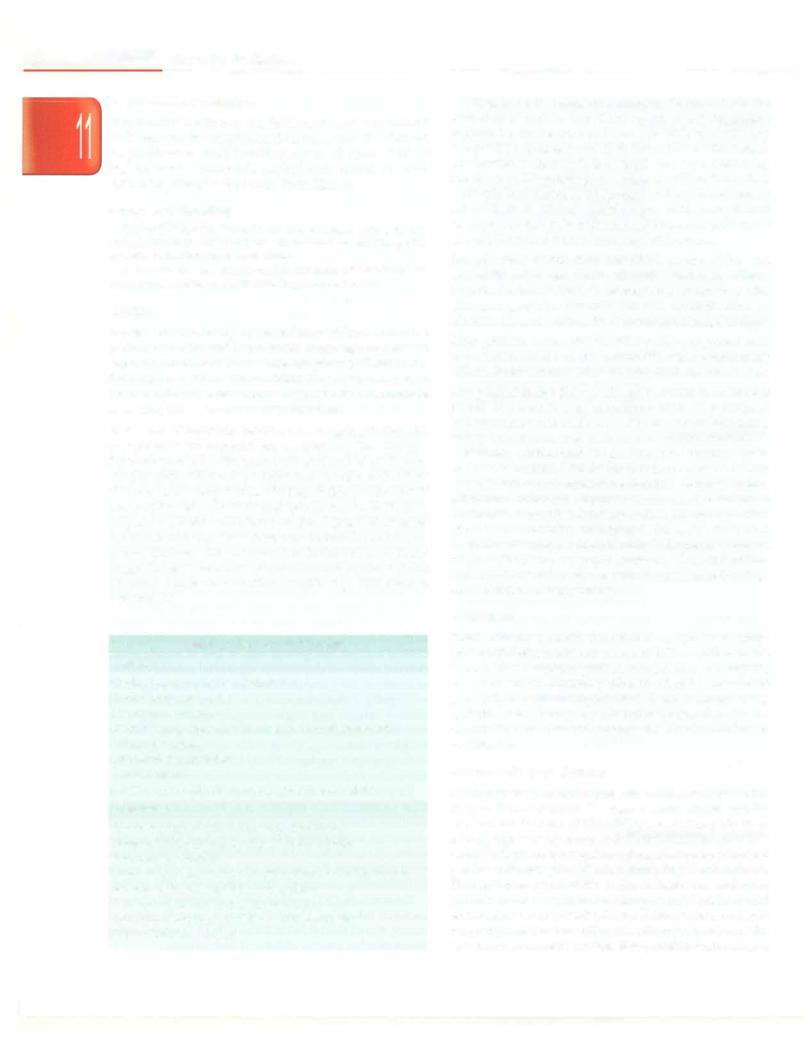
------------------------Essential Pediatrics
Hepatorenal Syndrome
Hepatorenal syndrome is a functional renal impairment as changes are reversible after liver transplant. It is defined as progressive renal insufficiency in absence of other known causes (prerenal, nephrotoxic drugs) of renal failure in patients with severe liver disease.
Suggested Reading
Debray D, Yousef N, Durand P. New management options for end stage chronic liver disease and acute liver failure: potential for pediat ric patients. Paediatr Drugs 2006;8:l-13
Leonis MA, Balistreri WF. Evaluation and management of end-stage liver ilisease in children. Gastroenterology 2008;134:1741-51
Ascites
Ascites is the pathologic accumulation of fluid within the peritoneal cavity and it can occur at any age and also in utero. The main causes of ascites are given in Table 11.32. Sometimes a large intra-abdominal cyst, i.e. cystic lymphangioma, omental or ovarian cyst can masquerade as ascites; this is known as pseudoascites.
Evaluation. History and examination, imaging studies and paracentesis are required for ascertaining the etiology. Patients present with increased abdominal girth and weight gain. Physical examination reveals abdominal distension, bulging flanks, shifting dullness, fluid thrill and puddle sign. The liver and spleen may be difficult to palpate in patients with tense ascites. Dilated abdominal collaterals and caput medusae may be seen in ascites due to liver disease, while collaterals in flanks and on the back suggest inferior vena cava block. Elevated jugular venous pressure suggests a cardiac origin, e.g. constrictive pericarditis.
Table 11.32: Causes of ascites
Common
Cirrhosis and portal hypertension Budd-Chiari syndrome Nephrotic syndrome
Protein losing enteropathy: intestinal lymphangiectasia Tubercular ascites
Constrictive pericarditis Cardiac failure
Chylous: lymphatic obstruction, thoracic duct injury
Uncommon
Pancreatic: Pancreatitis, pancreatic duct injury Urinary: Obstructive uropathy, bladder rupture Intestinal perforation
Hepatobiliary: Bile duct perforation, veno-occlusive disease Serositis: SLE, eosinophilic enteropathy
Peritoneal dialysis, ventriculoperitoneal shunt Infections: Parvovirus, syphilis, cytomegalovirus Others: Epidemic dropsy
Ultrasound is a sensitive imaging technique for the detection of ascites. Free fluid layers in the dependent regions, i.e. the hepatorenal recess (Morrison pouch) and the pelvic cul-de-sac which is detected on ultrasound. Abdominal paracentesis is a simple test for determining the etiology. Diagnostic paracentesis should be done when ascites is first detected, at the time of hospitalization, or when there is clinical deterioration with unexplained !ever, abdominal pain or diarrhea. Ultrasound guided tap 1s warranted in children with loculated ascites.
Investigations. Ascitic fluid should be evaluated for total and differential cell count, albumin level and culture. Serum albumin is done to calculate the serum to ascites albumin gradient (SAAG), i.e. the concentration of albumin in serum minus its concentration in ascitic fluid.
High gradient ascites (SAAG 1.1 g/dl) suggests portal hypertension and is seen in cirrhosis, fulminant hepatic failure, Budd-Chiarisyndrome and portal vein thrombosis.
Low gradient ascites (SAAG <1.1 g/dl) occurs in absence of portal hypertension in conditions such as peritoneal carcinomatosis, tuberculous peritonitis, pancreatic ascites, biliary leak ascites, nephrotic syndrome and serositis.
Elevated ascitic fluid level of amylase indicates pan creatitis or intestinal perforation. Polymicrobial infection is consistent with intestinal perforation, whereas mono microbial infection suggests spontaneous bacterial peritonitis. Uroascites is present when the concentration of urea and creatinine are higher in the ascitic fluid than in serum. Elevated ascitic bilirubin indicates perforation of the biliary tree or upper intestine. Chylous ascites, indicated by its milky appearance, is characterized by high concentration of triglycerides.
Treatment
Small amounts of ascitic fluid that do not produce symp toms or clinicalsequelae may require little or no treatment. Tense ascites causing respiratory compromise, severe pain, or other major clinical problems should be treated promptly. Treatment largely depends upon the cause, e.g. antitubercular therapy for tubercular ascites, diuretics for chronic liver disease and surgery for bile duct or bowel perforation.
Ascites with Liver Disease
In liver disease, ascites represents a state of excess total body sodium and water. The main postulated pathogenetic mechanisms include: (i) Underfilling theory: Primarily there is inappropriate sequestration of fluid within the splanchnic vascular bed as a consequence of portal hypertension that produces decrease in effective circulating blood volume. This activates the plasma renin, aldosterone and sym pathetic nervous system, resulting in renal sodium and water retention. (ii) Overfill theon;: Primary abnormality is inappropriate renal retention of sodium and water in the absence of volume depletion. Basis of this theory is that
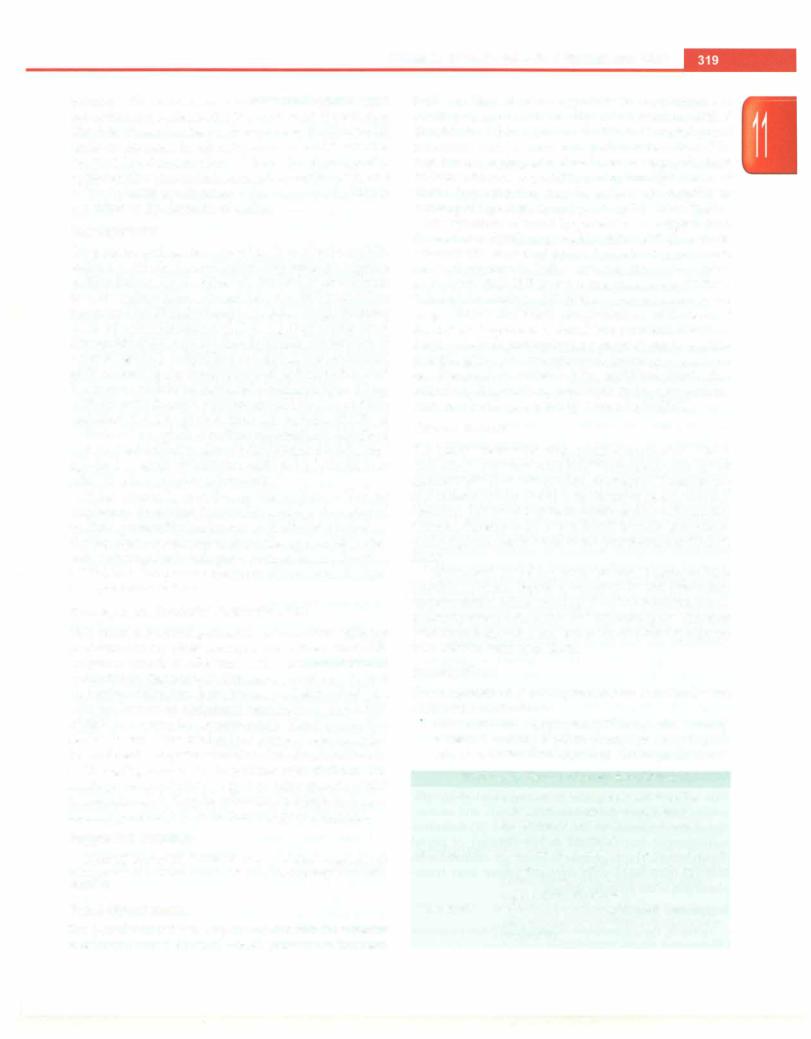
Diseases of Gastrointestinal System and Liver
patients with cirrhosis have intravascular hypervolemia rather than hypovolemia. (iii) Peripheral arterial vasodilation:
The chiefcause ofascites is splanchnic vasodilation, which leads to decrease in effective arterial blood volume. Progressive deterioration of liver functions, portal hypertension, splanchnic arterial vasodilatation and reduced plasmaoncotic pressure due tolowserum albumin contribute to development of ascites.
Management
For patients with ascites related to liver disease, mobili zationofasciticfluidisaccomplishedbycreatinganegative sodium balance until ascites has diminished or resolved; then the sodium balance is maintained so that ascites does not recur. Oral diuretic therapy consists of single morning dose of spironolactone (0.5-3 mg/kg) along with furosemide (0.5-2 mg/kg), that facilitates maintenance of normokalemia. If weight loss and decrease in abdominal girth are inadequate the doses of both spironolactone and furosemide should be increased simultaneously. Along with diuretic therapy patients should be on a sodium restricted diet. One gram of table salt contains 17 mEq of sodium and one gram of sodium approximates 44 mEq of sodium.Restrictionofsodiumindietislimitedto1-2mEq/ kg/day for infants and children and 1to 2 g/ day (44 to 88 mEq of sodium/day) in adolescents.
If the ascites is massive or the patient is having respiratory discomfort, large volume paracentesis should be done preferably under cover of albumin infusion. Patients whoare resistant to above therapy canbe treated with transjugular intrahepatic portosystemic shunting (TIPS) as a temporary measure till orthotopic liver transplantation is done.
Spontaneous Bacterial Peritonitis (SBP)
This refers to bacterial peritonitis not associated with gut perforation or any other secondary cause. Presence of >250 polymorphonuclear cells/mm3 with a positive culture of ascitic fluid isdiagnostic.Patientspresent withrapid onset abdominal distension, fever, malaise and abdominal pain with tenderness on abdominal examination. About 10% of SBP cases may be asymptomatic. Third generation cephalosporins, for atotal of 5 to 7daysare recommended for treatment. Longterm administration oforal norfloxacin 5-7.5 mg/kg once a day in patients with cirrhosis and ascitic protein content of <1 g/dl or prior episode of SBP is recommended. Despite advances in supportive care, bacterial peritonitis is an indicator of poor prognosis.
Suggested Reading
Giefer MJ, Murray KF, Colletti RB. Pathophysiology, diagnosis and management of pediatric ascites. J Pediatr Gastroenterol Nutr 2011; 52:503-13
Portal Hypertension
The portal vein is formed by the splenic and the superior mesenteric veins. Normal portal pressure is between
5-10 mm Hg and portal hypertension is an increase in portal pressure of >12 mm Hg. It is a common clinical situation in children and occurs due to increased portal resistance and/or increased portal blood flow. The presence of esophageal varices on endoscopy is the most definite evidence of portal hypertension. The causes of portal hypertension may be either intrahepatic or extrahepatic (prehepatic and posthepatic) (Table 11.33).
The spectrum of portal hypertension in children from developed vs. developingworldis different.Intheformer, intrahepatic causes of portal hypertension are most common whereas in India, extra hepatic portal venous obstruction (EHPVO) is the commonest cause (50-75%) followed by cirrhosis (25-35%); uncommon causes are congenital hepaticfibrosis, noncirrhoticportalfibrosisand Budd-Chiari syndrome. Portal hypertension results in development of portosystemic venous channels at diffe rent sites giving rise to esophageal, gastric or colonic vari ces. Neonatal umbilical sepsis, umbilical vein cathe terization, dehydration, peritonitis or hypercoagulable state may be the precipitating factors for EHPVO.
Clinical Features
The age ofpresentationranges from 4 months to adults. A majority of patients with EHPVO present with upper gastrointestinalbleedingandsplenomegaly. Hematemesis and melena occurs due to esophageal or gastric variceal bleeding.Thebleedmay be recurrent and is well tolerated without development of postbleed hepatic encephalo pathy.Splenomegaly alone is the presentation in 10-20% cases.
Patients with portal hypertension due to cirrhosis have jaundice, ascites, hepatosplenomegaly and less often, upper gastrointestinalbleeding.InBudd-Chiari syndrome, patients present with ascites and hepatomegaly. Tortuous prominent back veins are seen in Budd-Chiari syndrome with inferior vena cava block.
Investigations
The diagnosis of portal hypertension is made by the following investigations:
1.Ultrasound and Doppler study. The vascular anatomy is defined and any block in portal, splenic or hepatic veins can be detected. Increased size of portal vein is
Table 11.33: Causes of portal hypertension
Prehepatic |
Portal venous thrombosis, extrahepatic |
|
portal venous obstruction (cavernous |
|
transformation of portal vein), isolated |
|
splenic vein thrombosis |
Intrahepatic |
Liver cirrhosis (common), congenital hepatic |
|
fibrosis, veno-occlusive disease, noncirrhotic |
|
portal fibrosis, schistosomiasis, nodular |
|
regenerative hyperplasia |
Posthepatic |
Budd-Chiari syndrome (hepatic vein or |
|
inferior vena cava obstruction), constrictive |
|
pericarditis |
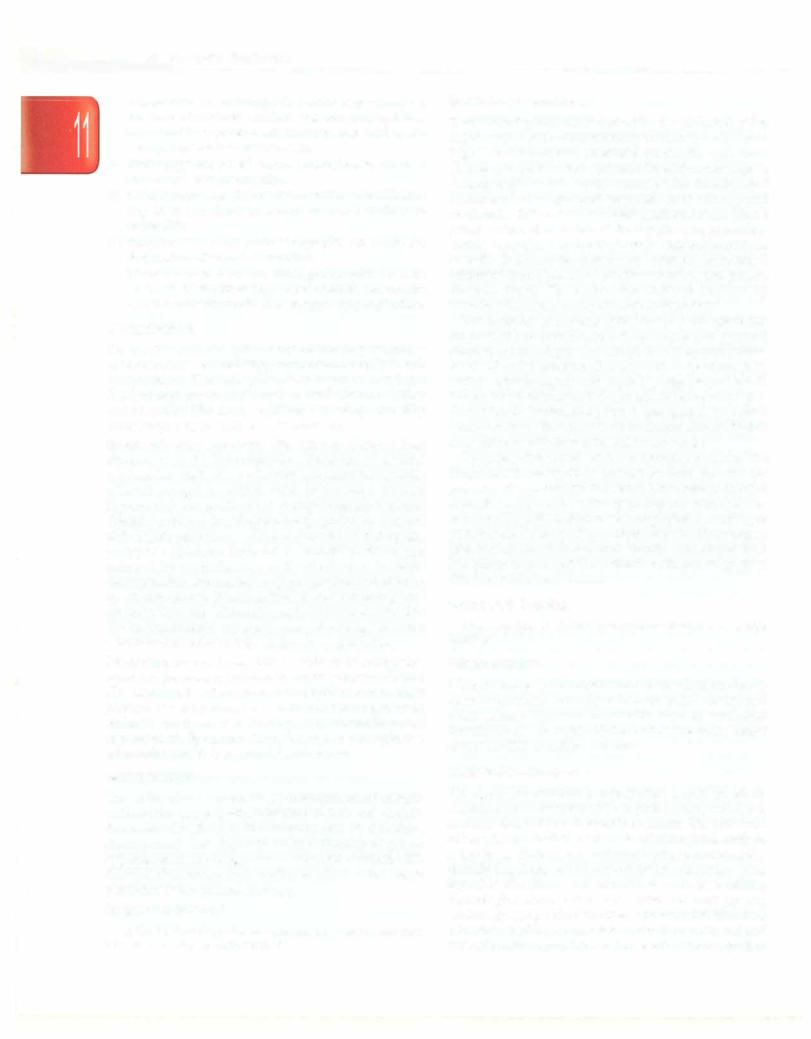
|
n i |
___________________________ |
Es se__ta_l_P_de__tiari s c |
||
__ |
|
|
suggestive of intrahepatic portal hypertension. Presence of collaterals, ascites, splenomegalyandliver abnormalities (altered echotexture, size and space occupying lesions) are also seen.
ii.Endoscopy can reveal varices in esophagus, stomach and congestive gastropathy.
iii.Colonoscopy is useful in children with lower GI bleed ing as it can show presence of rectal varices or colopathy.
iv.Selective CT or MR portovenography are useful for delineation of vascular anatomy.
v.Liver function tests are deranged in subjects with cirrhosis. Hemogram may show anemia, leukopenia and thrombocytopenia that suggests hypersplenism.
Complications
The most common complication is GI bleeding secondary to esophageal varices. Hypersplenism usually is not symptomatic. The enlarged spleen is prone to splenic infarcts and accidental rupture with trauma. Other complications like ascites and hepatic encephalopathy occur frequently in children with cirrhosis.
Hepatopulmonary syndrome. The triad of chronic liver disease or portal hypertension, alteration of arterial oxygenation (defined as widened age corrected alveolar arterial oxygen gradient with or without arterial hypoxemia) and evidence of intrapulmonary vascular dilatations defines hepatopulmonary syndrome. Patients with hepatopulmonary syndrome present with dyspnea, platypnea (dyspnea induced in upright position and relieved by recumbency) and orthodeoxia (arterial deoxygenationaccentuatedinuprightposition andrelieved by recumbency). Examination shows clubbing and cyanosis. Contrast echocardiography is the most sensitive test to demonstrate intrapulmonary shunting. The only established effective therapy is liver transplantation.
Portopulmonary syndrome. This is defined as pulmonary arterialhypertension (pulmonary arterypressure >25 mm Hg) associated with severe portal hypertension. Most patients of portopulmonary syndrome have underlying cirrhosis but it can also develop in noncirrhotic portal hypertension. Symptoms include dyspnea and syncope; echocardiography is required for diagnosis.
Management
This is based on two goals: (i) management of compli cations like upper gastrointestinal bleeds and ascites, discussed elsewhere in the chapter; and (ii) definitive management that depends on the etiology of portal hypertension. The prognosis is better for children with EHPVO than those with cirrhosis where liver trans plantation is the ultimate therapy.
Suggested Reading
Yachha SK. Portal hypertension in children: An Indian perspective. J Gastroenterol Hepatol 2002;17:5228-31
Budd-Chia r i Syndrome
Budd-Chiari syndrome is caused by the occlusion of the hepatic veins and/or the suprahepatic inferior vena cava. Right heart failure and sinusoidal obstruction syndrome (formerlyknown asveno-occlusivedisease)impair hepatic venous outflow and share features with Budd-Chiari syndrome, but are grouped separately as its etiologyand treatment is different. Budd-Chiari syndrome is considered primary when obstruction of the hepatic venous outflow tract is result of anendoluminalvenous lesion (thrombosis or web). It is considered secondary when the obstruction originates from alesionoutside the venous system (tumor, abscess, cysts). The lesion can obstruct outflow by invading the lumen or by extrinsic compression.
The majority of patients with Budd-Chiari syndrome areprimaryandpresentwithachroniccourse; onlyasmall number of patientspresent with acute or fulminant forms. Acute disorder presents clinically with abdominal pain, ascites, hepatomegaly and rapidly progressive hepatic failure. The chronic form is characterized by hepatomegaly abdominal distension and portal hypertension. In inferior vena cava block, the back veins become prominent, dilated and tortuous with flow from below upwards.
Doppler ultrasound and venography confirm the diagnosis. Investigations should be done to look for presence of hypercoagulable states. Treatment is directed towards restoring the patency of hepatic vein/inferior vena cava by radiological means (angioplasty, stenting or trans-jugular intrahepatic portosystemic shunt) or surgery (mesoatrial shunt, mesocaval shunt). Orthotopic liver transplant is reserved for patients with end stage liver disease or fulminant failure.
Suggested Reading
Plessier A, Valla DC. Budd-Chiari syndrome. Semin Liver Dis 2008; 28:259-69
Wilson Disease
Wilson disease is an inborn error of metabolism due to toxic accumulation of copper in liver, brain, cornea and other tissues. It occurs worldwide with an estimated prevalence of 1 in 30,000-50,000 and is one of the major causes of CLD in Indian children.
Clinical Presentation
The age of presentation can vary from 4 to 60 yr. Mani festations are more likely to be hepatic in early childhood and neurological in adolescents or adults. The spectrum of hepatic manifestations include all forms of chronic or acute liver disease, i.e. asymptomatic hepatomegaly, chronic hepatitis, portal hypertension, cirrhosis, 'viral hepatitis' like illness and sometimes acute liver failure. Neurological abnormalities are varied and may present as clumsiness, speechdifficulties, scholastic deterioration, behavioral problems, convulsions andchoreoathetoid and dystonic movements. Most of these patients have past or

Diseases of Gastrointestinal System and Liver
concurrent history of biochemical evidence of liver disease. Due to the slow and nonspecific evolution of neurological signs, it sometimes takes 1-2 yr to manifest from onset of symptoms. Other presentations are with bony deformities (knock knees) suggestive of resistant rickets, acute or recurrent hemolysis and failure to thrive. In view of the diverse presenting features, a high index of suspicion is the key to diagnosis.
Investigations
Nosingletestis diagnosticbyitself; a group of tests is done to make the diagnosis. Serum ceruloplasmin is decreased (<20 mg/dl) in most patients. In symptomatic patients, the 24 hr urinary copper excretion is more than 100 µg/day. Kayser-Fleischer (KF) ring indicates long-standing disease and severe copper overload. KF rings are most common in children with neurological (96%) than hepatic (60%) and asymptomatic (10-20%) Wilson disease. Hepatic copper is the single best predictive marker and is considered to be the gold standard, with values usually above 250 µg/g dry weight of liver. Liver biopsy is required for hepatic copper estimation. Mutational diagnosis is difficult because of the occurrence of more than 200 mutations, each of which is rare. Mutational diagnosis is helpful in screening family membersof anindexpatienthomozygousfor this mutation.
Diagnosis
Wilson disease is strongly suggested by the presence of any two of thefollowing: low ceruloplasmin, high urinary copper and presence of KF ring. However, hepatic copper content should be estimated if diagnosis is in doubt.
Treatment
Foods with high copper content like organ meats (liver), chocolates and nuts should be avoided. Continuous life long pharmacotherapy is essential for management. Treatment entails two aspects: (i) Induction therapy aims to reduce copper to subtoxic threshold. This phase usually takes 4 to 6 months (as indicated by urinary copper <500 µg/day and nonceruloplasmin copper <25 mg/dl). D Penicillamine or trientine is often used as chelation therapy. Ammonium tetrathiomolybdate is the therapy of choice in neurological Wilson disease, but is not easily available in India. (ii) Maintenance therapy aimsto maintain a slightly negative copper balance so as to prevent its accumulation and toxicity. Penicillamine and trientine have been used for this phase for long periods. Zinc, in view of its low cost and safety profile, can be used for maintenance therapy especially if there are penicillamine side effects and in asymptomatic siblings.
D-Penicillamine and trientine. Large urinary excretion of copper (2 to 5 mg/day) is observed in the initial months of therapy, falling to 0.1-0.5 mg/day in the maintenance period. Penicillamine has many adverse effects like skin rash, bone marrow depression, nephrotic syndrome or neurological deterioration. Trientine has been used as an
alternative chelating agent especially for children intolerant to penicillamine. Trientine is increasingly used as first line drug with good efficacy and few side effects; both medications are given at a dose of 20 mg/kg/day in two divided doses.
Zinc. Zinc has been used as acetate, sulphate or gluconate salts. Zinc acts by inducing intestinal cell metallothionein, which binds copper to form mercaptides. The metallo thionine, withcopperis held in theintestinalcellsuntilit is sloughedout. Howeverzinc is a slowactingdrug thattakes longer time to achieve a negative copper balance and is therefore effectively used as maintenance therapy.
LivertransplantationisindicatedinchildrenwithWilson disease who present as acute liver failure or have decompensatedcirrhosis unresponsivetomedical therapy.
Suggested Reading
Roberts EA, Schilsky ML; American Association for Study of Liver Diseases (AASLD). Diagnosis and treatment of Wilson disease: an up date. Hepatology 2008;47:2089-11
Autoimmune Liver Disease
Autoimmune liver disease is characterized by hyper gammaglobulinemia, presence of circulating auto antibodies, necroinflammatory histology (interface hepatitis, portal plasma cell infiltration) on biopsy and response to immunosuppressive agents. The condition is common in girls. In children, autoimmune liver disease consists of autoimmune hepatitis, autoimmune sclerosing cholangitis and de nova autoimmune hepatitis after liver transplantation. The following two types of autoimmune hepatitis are recognized:
Type 1. Presence of antinuclear antibody and/or anti smooth muscle antibody; constitutes 60-70% cases. Type 2. Presence of antiliver kidney microsomal antibody (LKM); accounts for 20-30% cases.
Clinical Presentation
Children can present in one of the following ways:
i.Acute viral hepatitis like presentation (40%) with malaise, nausea, vomiting and jaundice. It may progress to acute hepatic failure particularly in children with type II disease.
ii.Insidious onsetliver disease (30-40%) with progressive fatigue, relapsing or prolonged jaundice lasting for months to years.
iii.Chronic liver disease and its complications (10-20%) with splenomegaly, ascites, variceal bleeding or hepatic encephalopathy.
Diagnosis
Autoimmune liver disease is a diagnosis of exclusion, based on the following criteria:
i.Positive autoantibodies
ii.Raised garnmaglobulins and IgG levels
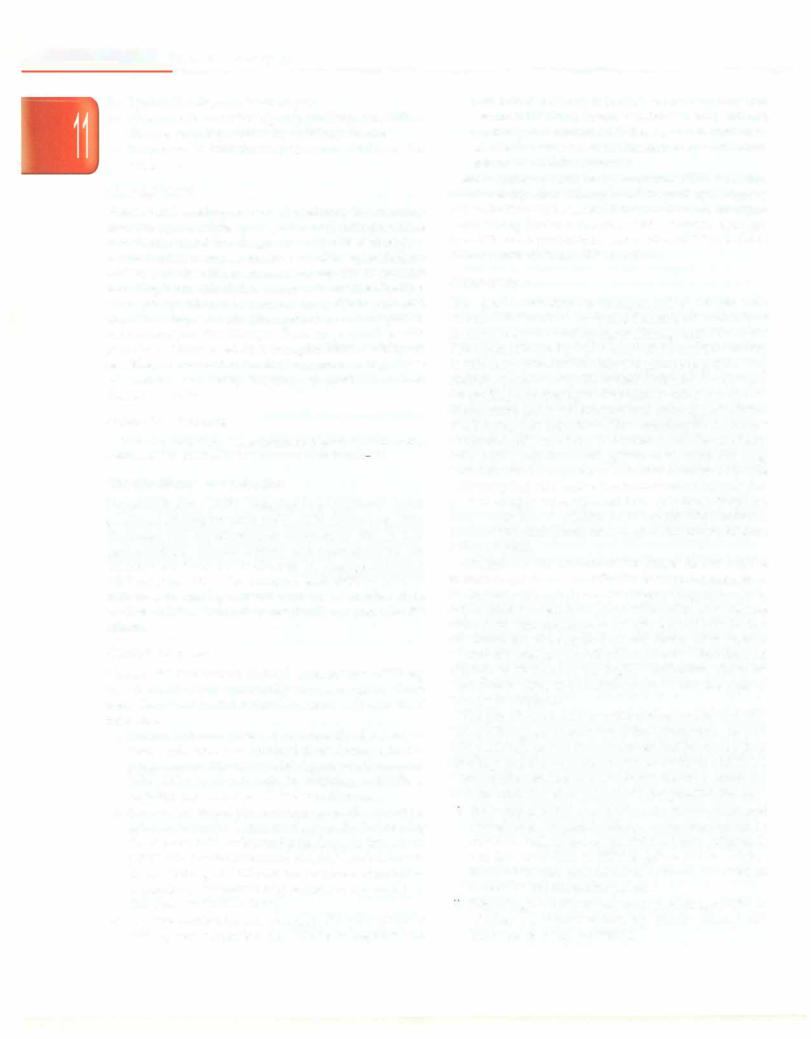
E s |
s_e_n_ t_ia_i_P_ei_da tr sic |
____________ |
________________ |
|
___ |
_ _ |
|
|
|
|
|
|
||
iii.Typical histology on liver biopsy
iv.Absence ofknownetiology, e.g. viral hepatitis, Wilson disease, drug hepatotoxicity or biliary disease
v.Response to immunosuppression confirms the diagnosis.
Management
Steroids and azathioprine are the primary immunosup pressive agents while cyclosporine and mycophenolate mofetil are second line drugs. The endpoint of therapy is normalization of transaminases and histological inflam matory activity with treatment. A majority of patients includingthosewithcirrhosisrespondtomedicaltherapy. Liver transplantation is required for patients with end stageliverstage who are either refractory or intolerant to immunosuppressive therapy. Patients presenting with acute liver failure need liver transplantation, as they are less likely to respond to medical treatment. A high index of suspicion and timely diagnosis of autoimmune liver disease is crucial.
Suggested Reading
Mieli-Vergani G, Vergani D. Autoimmune hepatitis in children: what is different from adult AIH? Semin Liver Dis 2009;29:297-306
Chronic Hepatitis B Infection
Hepatitis B virus (HBV) infection is a worldwide heath problem and may result in AVH, ALF, chronic hepatitis, cirrhosis and hepatocellular carcinoma (HCC). The epidemiology, natural history and evaluation for the infection are discussed in Chapter 10. The age at time of HBV infection affects the outcome, with >90% of infected neonates becoming chronic carriers as compared to 20-25% children infected in preschool age and only 5% adults.
Clinical Features
Chronic HBV infection is defined as persistence of HBsAg for >6 months. Three potentially successive phases have been described in the natural course of chronic HBV infection:
i.Immunetolerant phase is characterized by active viral replication and minimal liver damage. In this phase, serum HBsAg and HBeAg are positive, serum HBV DNA levels are high (in millions), anti-HBe is negative and serum ALT levels are normal.
ii.Immune clearance phase occurs years after immune tolerant phase and ischaracterizedbyeffort of clearing the chronic HBV infection by the host. In this serum HBV DNAlevelsare reduced and ALT levelsincrease. Serum HBsAg and HBeAg are positive and anti-HBe is negative. The patient may become symptomatic in this phase with ALT flares.
iii.Inactive carrier phase or nonreplicative phase follows HBeAg seroconversion, i.e. HBeAg is negative and
anti-HBe is positive. It is characterized by very low serum HBV DNA levels (<2,000 IU/ml), HBsAg positivity and normal ALT. It may lead to resolution of infection where serum HBsAg becomes undetect able and anti-HBs is present.
Most children with early acquired HBV infection spontaneously clear HBeAg by 15-30 yr of age. Majority of the children with chronic HBV infection are asympto matic during first two decades of life. Cirrhosis develops in 3-10% and hepatocellular carcinoma (HCC) in 1-4% of children with chronic HBV infection.
Management
The recommendations for management of children with chronic HBV include: (i) detailed examination and liver function tests; (ii) serology tests: HBeAg, anti-HBe, HBV DNA (quantitative by PCR). HCV RNA and HIV testing to rule out coinfection in high-risk groups (e.g. following multiple transfusions); (iii) consideration for liver biopsy for grading and staging of liver disease prior to initiation oftreatment; and (iv) identifying andtreatingpatientsthat merit therapy for hepatitis B. The ideal drug for treatment of chronic HBV infection in children is one that is cheap, safe, orally administered, given at all ages for long duration without any risk of viral resistance and capable of interrupting viral replication to undetectable levels.But no such drug is currently available. Only three drugs are licensed for use in children and they include interferon and oral antivirals [lamivudine and adefovir (for children >12 yr of age)].
Children in the nonreplicative phase do not require treatment and there is no effective therapy for patients in the immune-tolerant phase. Treatment is helpful for child ren in immune-clearance phase with active liver disease and raised transaminases as delayed loss of HBeAg is a risk factor for virus replication and favors development of cirrhosis and hepatocellular carcinoma. Therefore, an attempt at shortening the highly replicative phase by treatment is likely to be beneficial and forms the basis of therapy in children.
The aim oftreatmentis toachieve sustained loss ofHBV DNA, HBeAg seroconversion (HBeAg negative and anti HBe positive), normal transaminases and improved liver histology and thereby reduced risk of cirrhosis and HCC. Correctpatientandtherapyselectionisthekeytosuccessful management. The other aspects of managements include:
1.Followup of all infectedchildren for diseaseflares and surveillance for hepatocellular carcinoma should be ensured. Risk of cancer in HBV infected subjects is 100 fold more than in HBV negative patient. Alpha fetoprotein and abdominal ultrasound are used to screen for hepatocellular cancer.
11.Educatingthechildoradolescentregardingavoidance of other hepatotoxic factors, e.g. obesity, alcohol and intravenous drugs is essential
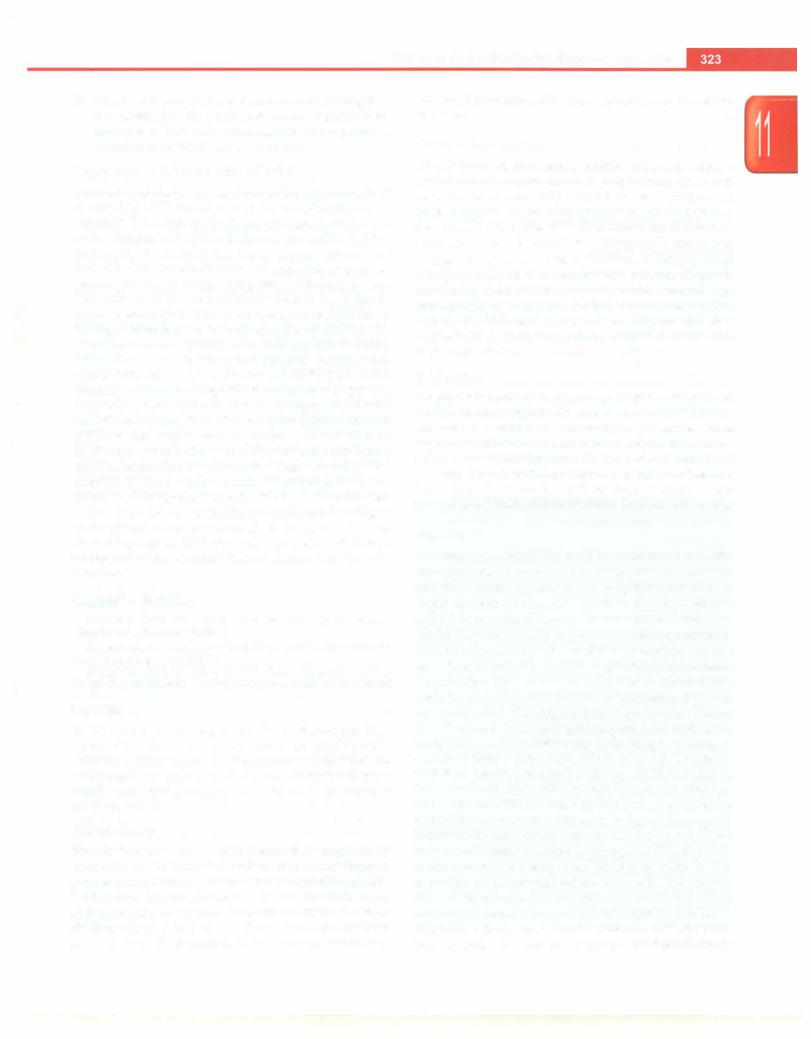
Diseases of Gastrointestinal System and Liver
iii.One should screen all family members of HBsAg posi tive patient for HBsAg. Vaccination of negative mem bers against HBV and evaluating other HBsAg positive members for liver disease is required.
Prevention of Chronic HBV Infection
Prevention is the most effective method of successfully controlling HBV infection and its complications. The hepatitis B vaccine is highly immunogenic with sero conversion ratesof>90%after three doses. Antibodytiters (anti-HBs) of >10 mIU/ml signify a response and are protective.Thedose inchildrenandadolescents (agedless than 18yr) is 0.5ml (10 µg). It is given in 3 doses at 0, 1 and 6 months as an intramuscular injection in the deltoid/ anterolateral thigh.Forprevention ofperinatalinfectionin HBsAgpositivemother,thebabyshouldbegivenHepatitis B Immune Globulin (HBIG)along with hepatitis B vaccine within 12 hr of birth, using two separate syringes and separate sites for injection. The dose of HBIG is 0.5 ml IM. The othertwo doses of hepatitis B vaccine may be given at 1 and 6 months or at 6 and 14 week to piggy back it with theDPTvaccination. Theefficacy ofprophylaxiswithboth HBIG and hepatitis B vaccine is 90-95%. All infants born toHBsAgpositivemothers shouldbetestedforHBsAgand anti-HBs antibodies at 9-15months of ageto identifyHBV infested (HBsAg positive, anti-HBsAb negative) and protected (HBsAgnegative,anti-HBsAbpositive)children.
Universal infant vaccination, adequate screening of blood products and use of sterile syringes is a must for controlling chronicHBVinfection as preventionis always better and more feasible than cure especially in HBV infection.
Suggested Reading
Jonas MM. Treatment of chronic hepatitis B in children. J Pediatr Gastroenterol Nutr 2006;43: 556-560
Lok ASF, Mc Mahon BJ. Chronic hepatitis B (AASLD Practice guide lines). Hepatology 2007;45:507-39
Murray KF, Shah U, Mohan N, et al. Chronic Hepatitis Working Group. Chronic hepatitis. J Pediatr Gastroenterol Nutr 2008;47:225-33
Hepatitis C
HCV is anenveloped,single-stranded positive-sense RNA virus of the flavivirus family. Based on phylogenetic analysis of HCV sequences, 6 major HCV genotypes are recognized, designated 1 to 6, with multiple subtypes within each viral genotype. In India non-1 genotype is more prevalent.
Epidemiology
Worldwide prevalence of chronic HCV infection is estimated at 3%, with 150 million chronically infected people. Routesof transmission ofHCV are similartoHBV. Mother-to-infant transmission of HCV is the main mode of transmission in children. Hepatitis C affects 4-10% of children born to infected mothers, and 80% of them develop chronic infection. Children are considered
infected if the serum HCV RNA is positive on at least two occasions.
Clinical Presentation
Most children with chronic hepatitis C virus infection are asymptomatic or have mild nonspecific symptoms, with persistent or intermittently elevated or evennormal serum transaminases. Hepatomegaly may be present. Severe liverdiseasemay develop10-20 yrafteronsetof infection, with a less than 2% overall risk during the pediatric age.
The natural course of HCV infection in children is not clearly understood, but overall advanced liver disease is rareduring childhood. In cases with verticaltransmission spontaneous clearance of infection may be seen by 5 to 7 yr of age. Children with transfusion-acquired infection mayhave higher ratesofspontaneousHCV clearance than those with vertically acquired HCV infection.
Evaluation
Diagnosis is made by testing for anti-HCV antibody and if positive, confirmed by the presence of HCV RNA. The presence of antibody shows that the patient has been exposed to the virus but does not discriminate between active or resolved infection. The absence of anti-HCV antibodyusually indicates that the patient is not infected. The diagnosis of chronic HCV infection is made on the basis of persistently detectable HCV RNA for :2:6 months.
Treatment
Combinationof interferon (thrice a weekof standard IFN subcutaneouslyoronceaweekofpegylatedIFN)andoral ribavirin (15 mg/kg maximum) daily for a period of 24 weeks for genotype 2 and 3 and 48 weeks for genotype 1 and 4 is the standard therapy for chronic HCV infection. The USFDAhasrecently approved combined pegylated IFN-a 2b plus ribavirin for treatment in children >3 yr of age. The addition of polyethylene glycol (PEG) increases the half-life ofIFN, reduces its volume of distribution and leads to more sustained plasma levels with better viral suppressionandallowingonceweeklyusage. Inchildren the rate of sustained virological response (6 months after completion of drug treatment) indicating resolution of chronic infection varies from 50% in genotype 1 patients, to 90% in genotypes 2 or 3 patients. Multi-transfused thalassemic children with hepatitis C virus infection can alsobetreated withIFNandribavirinwitharesponse rate of 60-72%. However, ribavirin induced hemolysis increases the transfusion requirement during treatment in these children. A frequently overlooked but critical component of the management of children with HCV is toprovide informationaboutthevirus, includingwaysto prevent its spread. Adolescents, in particular, need to understandthat alcohol accelerates progression ofHCV relatedliverdiseaseandshouldabstainfromitsconsump tion. The importance of avoiding high-risk behavior such
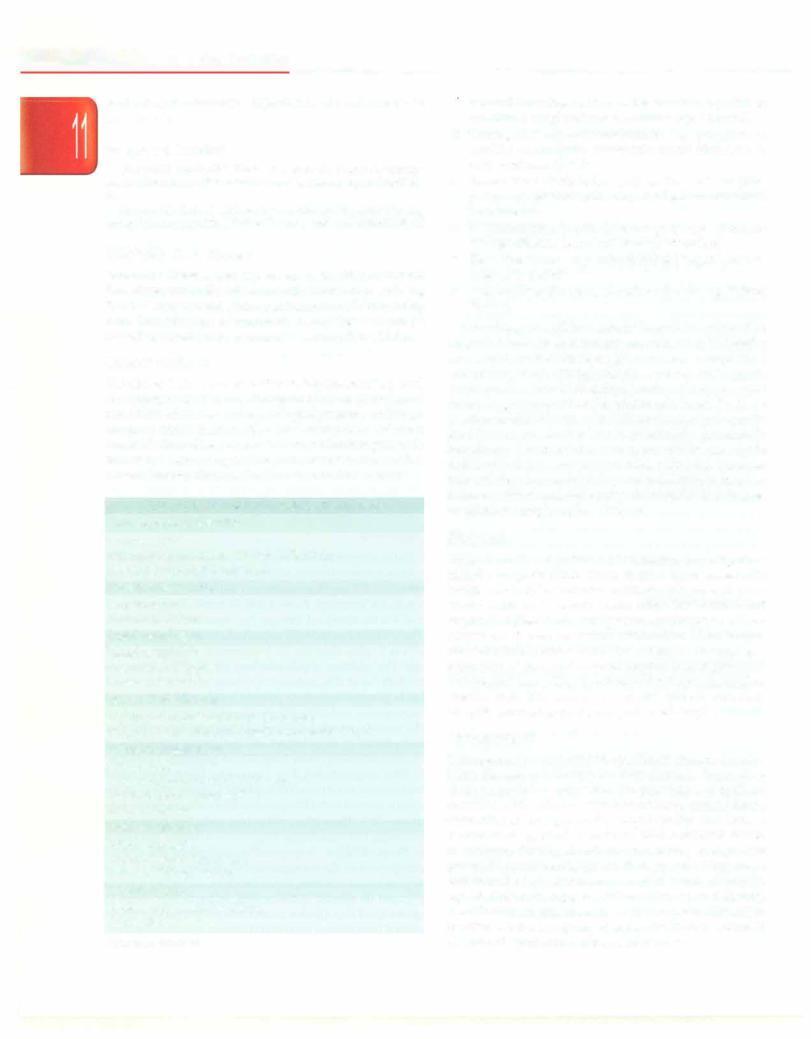
- Essen tialPed ia trics_________________________________
_______________
as sharing of intravenous injection needles also needs to be discussed.
Suggested Reading
Ghany MG, Strader DB, Thomas DL, Seeff LB. Diagnosis, manage ment and treatment of hepatitis C: an update. Hepatology 2009;49:1335-- 74
Murray KF, Shah U, Mohan N, et al. Chronic Hepatitis Working Group. Chronic hepatitis. J Pediatr Gastroenterol Nutr 2008;47:225-33
Metabolic Liver Disease
Metabolic diseases account for up to 15-20% of chronic liver disease in Indian children with Wilson disease being the mostfrequent and alpha-1-antitrypsin deficiency being rare. The etiology of metabolic liver diseases can be classified based on the primary substrate (Table 11.34).
Clinical Features
Theclinicalfeaturesaresecondary tohepatocyte injurywith development of cirrhosis, storage of lipids or glycogen, or metabolic effects secondary to hypoglycemia or hyper ammonemia. Clinical signs and symptoms of most metabolic liver diseases are similar and indistinguishable from those seen in acquired hepatic disorders due to other causes. Presentations can be broadly subdivided into:
Table 11.34: Causes of metabolic liver disease Carbohydrate metabolism
Galactosemia•
Glycogen storage disease* types I, III, IV, VI
Hereditary fructose intolerance
Protein metabolism
Tyrosinemia*
Urea cycle defects
Lipid metabolism
Gaucher disease*
Niemann-Pick type C*
Wolman disease
Bile acid metabolism
Benign recurrent intrahepatic cholestasis Progressive familial intrahepatic cholestasis* I, II, III
Bilirubin metabolism
Gilbert syndrome*
Crigler-Najjar syndrome type I and II*
Dubin-Johnson syndrome*
Rotor syndrome
Metal metabolism
Wilson disease*
Neonatal hemochromatosis
Indian childhood cirrhosis
Miscellaneous
Alpha-1-antitrypsin deficiency
Cystic fibrosis
*Common disorders
1.Isolatedunconjugated hyperbilirubinemia, e.g. Gilbert syndrome, Crigler-Najjar syndrome types I and II.
ii.Conjugated hyperbilirubinemia, e.g. progressive familial intrahepatic cholestasis, cystic fibrosis, bile acid synthesis defects.
iii.Severe liver dysfunction with ascites and coagulo pathy, e.g. galactosemia, neonatal hemochromatosis, tyrosinemia.
iv.Hepatomegaly, hepatosplenomegaly, e.g. glycogen storage disease, lysosomal storage disorders.
v.Reye like illness, e.g. mitochondrial hepatopathies, urea cycle defects.
vi.Chronic liver disease or acute liverfailure, e.g. Wilson disease.
The settings in which metabolic liver disease should be suspected include: (i) recurrent episodes of rapid deterio ration with minor illnesses; (ii) recurrent unexplained encephalopathy, hypoglycemia, acidosis and hyper ammonemia,asinmitochondrialhepatopathies,ureacycle defects, organic acidurias; (iii)consanguinity,sibdeaths or positive family history, as in Wilson disease; (iv) specific food intolerance or aversions in childhood, e.g. sugars in hereditary fructose intolerance, protein in urea cycle defects; (v) rickets and unusual urine odors, e.g. tyrosine mia; (vi) developmental delay and multisystem involve ment,e.g.mitochondrialhepatopathies; and (vii) fattyliver on ultrasonography or liver biopsy.
Diagnosis
Apart from the high index of suspicion, investigations include complete blood count, arterial blood gases with lactate, electrolytes, glucose, ammonia; plasma and urine amino acids and organic acids; urine for ketones and sugars. Samples of urine andplasma, skin biopsy andliver biopsy are frozen for future evaluation. Liver biopsy provides information about the extent of damage and estimation of abnormal material (copper,ironor glycogen) and enzyme assay. Confirmation of the diagnosis requires specific tests like enzyme assay and genetic mutation analysis depending on the suspected etiology.
Management
Management is two pronged; specific treatment of under lying disease and therapy for liver damage. Supportive therapy includes measures like provision of optimal nutrition with vitamin supplementation, antioxidants, correction of hypoglycemia, coagulopathy and ascites, vaccination against infections like hepatitis B and monitoring for hepatocellular carcinoma in high-risk groupsliketyrosinemia.Specifictherapyismostimportant and should be given whenever available and affordable, e.g. chelation therapy for Wilson disease and dietary modificationforgalactosemia. Livertransplantationmight be offered to a select group of metabolic liver disorders, in absence of significant multisystem disease.
